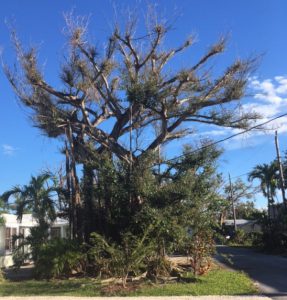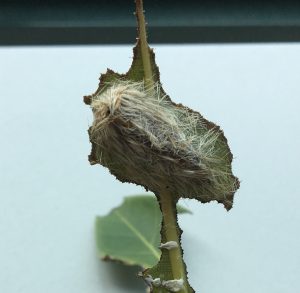Skeletonized leaves; Help! Help! What’s killing my Ficus trees? These are the questions, subject lines, and visits to our Extension office that have filled my days the last couple weeks. Residents saying, “It sounds like it’s raining under my tree” and explaining their large, 40-foot Ficus trees (including Strangler Fig), “appear to be defoliated overnight.” It’s the Edwards Wasp Moth Caterpillar and pest populations seem to fluctuate from year to year.

Previously described as the rubber tree caterpillar, since they are specifically a pest of Ficus species, this year they seem to be particularly destructive. The caterpillars are pale yellow to cream colored with dense hairs covering their entire body. A tuft of darker hairs arise a bit behind a reddish-brown head. The adult is an attractive bluish-grey moth with an orange head and bluish-grey, feather-like antennae. The pupae, covered in a cocoon of hairs, seem to have a particular affinity for the walls and outdoor screens of homes. Does this sound familiar? You can take comfort in knowing there are quite a few natural enemies that do a pretty good job of control, especially tiny, parasitic insects that prey on the caterpillar and pupal stage.


So why is this caterpillar so destructive this year? Many factors could be playing a role in the higher populations noticed this year, such as the moth’s populations getting ahead, briefly, of their natural enemies populations. We also have been having erratic weather patterns, including Hurricane Irma, which wreaked havoc on the foliage and landscapes here in the Keys.
Ultimately when our office is contacted, people want to know what they can do about this pest. Be patient! Mature trees should be able to handle periodic defoliation. A heavy stream of water may do a good job of knocking down the pupa and caterpillars, within reach. In the event the infestation is caught early, and you have a fairly manageable sized tree, the caterpillars can be controlled with a microbial insecticide called Bacillus thuringiensis (B.t.), it is sold under many trade names and is available in many formulations. There are strains specific to caterpillars so not to harm beneficial insects. Always follow label directions and make sure you are applying the correct strain! There are not many systemic, soil-applied insecticides, that offer control of caterpillars and if the tree is already defoliated, they would be ineffective. Remember contact insecticides might not be feasible for large-sized trees since it would have to be sprayed directly onto the leaves and make contact with the caterpillars. Be cautious with this type of application as drift onto other plant material and beneficial insects is always a concern. It is a violation of federal law to apply a pesticide that is inconsistent with its label directions. The label is the law!
We all are recovering from Irma, that includes the environment too and things just may need time to get back on track. So, monitor your trees, it’s too soon to tell if there will be any dieback in branches because of the stress with Irma and now this caterpillar, but this isn’t a new pest and trees do usually recover from defoliation. Our native Strangler Fig is semi-deciduous and does lose its leaves this time of year. To monitor your trees health, take a picture of your tree now and again in a month or so to document growth. Remember there are natural enemies that prey on this insect, and may just need time for their populations to increase to have effective control.
References for this article:
Genung W.G. 1959. Notes on the syntomid moth Lymire edwardsii (Grote) and its control as a pest of Ficus in south Florida. Florida Entomologist 42: 39-42.
Habeck D.H., Mead F.W. 2000. Edwards Wasp Moth, Lymire edwardsii (Grote) EENY182. Gainesville: University of Florida Institute of Food and Agricultural Sciences. Retrieved March 05, 2018 from https://edis.ifas.ufl.edu/pdffiles/IN/IN33900.pdf
 0
0
